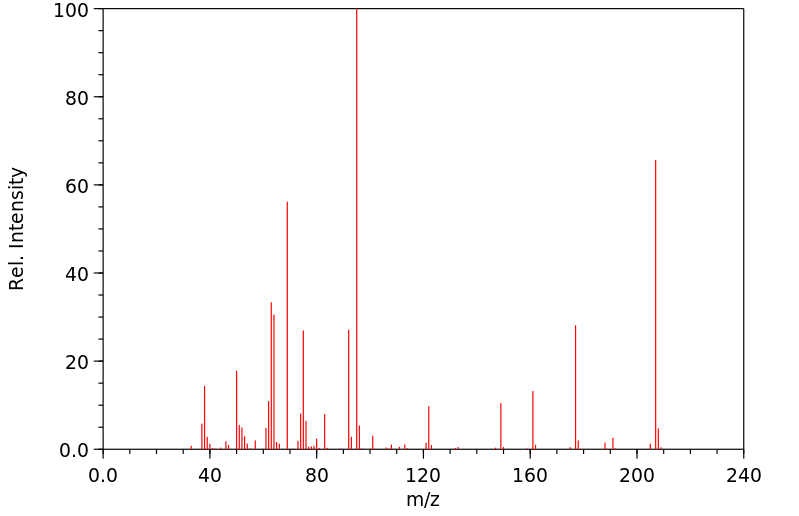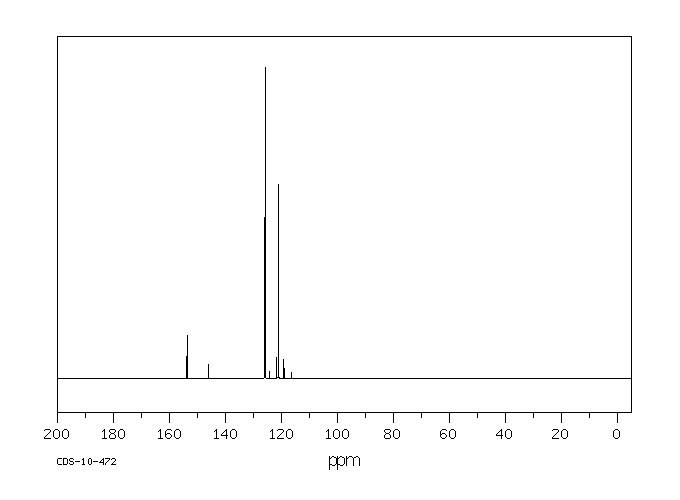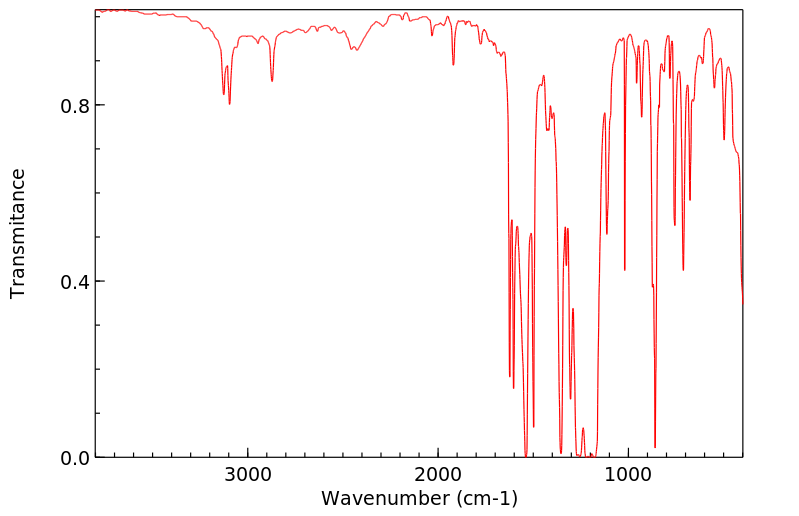1-硝基-4-(三氟甲氧基)苯 | 713-65-5
-
物化性质
-
计算性质
-
ADMET
-
安全信息
-
SDS
-
制备方法与用途
-
上下游信息
-
文献信息
-
表征谱图
-
同类化合物
-
相关功能分类
-
相关结构分类
物化性质
-
熔点:15°C
-
沸点:87 °C
-
密度:1,447 g/cm3
-
闪点:87-89°C/15mm
-
溶解度:氯仿(可溶)、甲醇(微溶)
-
稳定性/保质期:
远离氧化物、高温和明火。
计算性质
-
辛醇/水分配系数(LogP):3.2
-
重原子数:14
-
可旋转键数:1
-
环数:1.0
-
sp3杂化的碳原子比例:0.142
-
拓扑面积:55
-
氢给体数:0
-
氢受体数:6
安全信息
-
危险等级:IRRITANT
-
危险品标志:Xi
-
安全说明:S26,S36
-
危险类别码:R36/37/38
-
海关编码:2909309090
-
危险性防范说明:P305+P351+P338
-
危险性描述:H227,H315,H319,H335
-
储存条件:存放在密封容器中,并放置在阴凉、干燥处。储存地点需远离氧化剂。
SDS
| Name: | 1-Nitro-4-(trifluoromethoxy)benzene 97% Material Safety Data Sheet |
| Synonym: | |
| CAS: | 713-65-5 |
Synonym:
Section 2 - COMPOSITION, INFORMATION ON INGREDIENTS
| CAS# | Chemical Name | content | EINECS# |
| 713-65-5 | 1-Nitro-4-(trifluoromethoxy)benzene | 97% | unlisted |
Risk Phrases: 36/37/38
Section 3 - HAZARDS IDENTIFICATION
EMERGENCY OVERVIEW
Irritating to eyes, respiratory system and skin.
Potential Health Effects
Eye:
Causes eye irritation.
Skin:
Causes skin irritation. May be harmful if absorbed through the skin.
Ingestion:
May cause irritation of the digestive tract. May be harmful if swallowed.
Inhalation:
Causes respiratory tract irritation. May be harmful if inhaled.
Chronic:
Not available.
Section 4 - FIRST AID MEASURES
Eyes: Flush eyes with plenty of water for at least 15 minutes, occasionally lifting the upper and lower eyelids. Get medical aid.
Skin:
Get medical aid. Flush skin with plenty of water for at least 15 minutes while removing contaminated clothing and shoes.
Ingestion:
Get medical aid. Wash mouth out with water.
Inhalation:
Remove from exposure and move to fresh air immediately. If not breathing, give artificial respiration. If breathing is difficult, give oxygen. Get medical aid.
Notes to Physician:
Treat symptomatically and supportively.
Section 5 - FIRE FIGHTING MEASURES
General Information:
As in any fire, wear a self-contained breathing apparatus in pressure-demand, MSHA/NIOSH (approved or equivalent), and full protective gear.
Extinguishing Media:
Use water spray, dry chemical, carbon dioxide, or chemical foam.
Section 6 - ACCIDENTAL RELEASE MEASURES
General Information: Use proper personal protective equipment as indicated in Section 8.
Spills/Leaks:
Absorb spill with inert material (e.g. vermiculite, sand or earth), then place in suitable container.
Section 7 - HANDLING and STORAGE
Handling:
Avoid breathing dust, vapor, mist, or gas. Avoid contact with skin and eyes.
Storage:
Store in a cool, dry place. Store in a tightly closed container.
Section 8 - EXPOSURE CONTROLS, PERSONAL PROTECTION
Engineering Controls:
Facilities storing or utilizing this material should be equipped with an eyewash facility and a safety shower. Use adequate ventilation to keep airborne concentrations low.
Exposure Limits CAS# 713-65-5: Personal Protective Equipment Eyes: Not available.
Skin:
Wear appropriate protective gloves to prevent skin exposure.
Clothing:
Wear appropriate protective clothing to prevent skin exposure.
Respirators:
Follow the OSHA respirator regulations found in 29 CFR 1910.134 or European Standard EN 149. Use a NIOSH/MSHA or European Standard EN 149 approved respirator if exposure limits are exceeded or if irritation or other symptoms are experienced.
Section 9 - PHYSICAL AND CHEMICAL PROPERTIES
Physical State: Liquid
Color: colorless - pale yellow
Odor: Not available.
pH: Not available.
Vapor Pressure: Not available.
Viscosity: Not available.
Boiling Point: 87 - 89 deg C @15mmHg
Freezing/Melting Point: Not available.
Autoignition Temperature: Not available.
Flash Point: Not available.
Explosion Limits, lower: Not available.
Explosion Limits, upper: Not available.
Decomposition Temperature:
Solubility in water:
Specific Gravity/Density:
Molecular Formula: C7H4F3NO3
Molecular Weight: 207
Section 10 - STABILITY AND REACTIVITY
Chemical Stability:
Not available.
Conditions to Avoid:
Incompatible materials.
Incompatibilities with Other Materials:
Oxidizing agents, reducing agents, acids, bases.
Hazardous Decomposition Products:
Nitrogen oxides, carbon monoxide, carbon dioxide, fluorine, hydrogen fluoride gas.
Hazardous Polymerization: Has not been reported
Section 11 - TOXICOLOGICAL INFORMATION
RTECS#:
CAS# 713-65-5 unlisted.
LD50/LC50:
Not available.
Carcinogenicity:
1-Nitro-4-(trifluoromethoxy)benzene - Not listed by ACGIH, IARC, or NTP.
Section 12 - ECOLOGICAL INFORMATION
Section 13 - DISPOSAL CONSIDERATIONS
Dispose of in a manner consistent with federal, state, and local regulations.
Section 14 - TRANSPORT INFORMATION
IATA
No information available.
IMO
No information available.
RID/ADR
No information available.
Section 15 - REGULATORY INFORMATION
European/International Regulations
European Labeling in Accordance with EC Directives
Hazard Symbols: XI
Risk Phrases:
R 36/37/38 Irritating to eyes, respiratory system
and skin.
Safety Phrases:
S 26 In case of contact with eyes, rinse immediately
with plenty of water and seek medical advice.
S 37/39 Wear suitable gloves and eye/face
protection.
WGK (Water Danger/Protection)
CAS# 713-65-5: No information available.
Canada
None of the chemicals in this product are listed on the DSL/NDSL list.
CAS# 713-65-5 is not listed on Canada's Ingredient Disclosure List.
US FEDERAL
TSCA
CAS# 713-65-5 is not listed on the TSCA inventory.
It is for research and development use only.
SECTION 16 - ADDITIONAL INFORMATION
N/A
制备方法与用途
应用
1-硝基-4-(三氟甲氧基)苯又叫对硝基三氟甲氧基苯,是合成对三氟甲氧基苯胺的重要原料。对三氟甲氧基苯胺作为含氟有机中间体,可广泛应用于农药、医药及液晶材料中,如用于合成各种杀虫剂和除草剂、电子照相材料、活性光纤,以及治疗心血管、糖尿病等医药产品。随着这些下游产品的不断开发,对三氟甲氧基苯胺的需求量也会逐渐增加。
制备
以纯的三氟甲氧基苯为原料,使用发烟硝酸与浓硫酸的混合酸(其中硝酸质量浓度为23.6%,水质量浓度为3%)作为硝化剂。通过两台连续输送设备SeriesⅡ型数字泵分别以1.0 mL/min和1.4 mL/min的流量进料,即以摩尔量计,硝酸与三氟甲氧基苯的进料比为1.17。原料与硝化酸在通道当量直径为0.6mm、持液体积为0.4mL的并行微通道反应器内强烈混合,并经初始反应(经测试反应物转化率为46%~51%),然后将混合后的物料进一步在微通道反应器后部的反应停留设备第二反应器(填料管)内进行混合和反应。该填料管具有38.4%~40%的空隙率,为具有混合元件的列管反应器,使反应物料在第二反应器内停留30秒。同时,控制微通道反应器和列管反应器内的反应温度均为20℃,列管出口得到产物硝基三氟甲氧基苯及废酸。分离两相后,以10%水萃取酸相中的有机物,并合并上层产物。接着使用水和碱水交替洗涤产物至中性,最终通过Agilent 7890气相色谱仪检测,色谱柱为DB-1701,以峰面积定量间位、对位及邻位一硝化物及二硝化物的浓度。经分析:原料转化率高达99.8%,其中间位、对位和邻位一硝化物分别为0.07%、91.5%、7.4%,二硝化物为0.5%。
化学性质
本品为固体。
用途
生产方法
其制备方法是将对硝基苯酚和四氯化碳用HF进行氟化,得到4-三氟甲氧基硝基苯。具体过程如下:将氟化氢引入到含有对硝基苯酚和四氯化碳的弹式反应器中,在SbCl₅催化剂存在下与无水SbF₃反应,在氮气流下混合物于100℃搅拌反应2小时,然后在150℃搅拌反应。
上下游信息
反应信息
-
作为反应物:描述:参考文献:名称:硝基芳烃的光诱导还原以及与卤代芳烃的串联 C-N 交叉偶联摘要:使用简单且廉价的 Ni(acac) 2作为助催化剂,开发了硝基芳烃与卤代芳烃的高效光催化 C-N 交叉偶联。该反应被证实是一个逐步过程:(1)无金属光诱导硝基芳烃还原成苯胺衍生物,(2)苯胺与卤代芳烃的光催化和镍催化C-N交叉偶联。反应条件简单温和,可得到高价值的二芳基胺,具有良好的收率和良好的官能团耐受性。DOI:10.1021/acs.orglett.3c03656
-
作为产物:描述:参考文献:名称:N-硝基杂环:用于芳基和杂芳基硼酸的催化Ipso硝化的稳定型有机试剂。摘要:光催化与通过不含金属的协议来访问各种芳族和杂芳族硝基化合物本位基于非金属使用被开发容易得到的硼酸衍生物的-nitration,长凳稳定的,并可回收硝化试剂。这些方法操作简便,温和,区域选择性,并且具有出色的官能团相容性,可提供高达99%的收率的所需产品。DOI:10.1021/acs.orglett.0c00671
文献信息
-
Cyclic (Alkyl)(amino)carbene Ligand-Promoted Nitro Deoxygenative Hydroboration with Chromium Catalysis: Scope, Mechanism, and Applications作者:Lixing Zhao、Chenyang Hu、Xuefeng Cong、Gongda Deng、Liu Leo Liu、Meiming Luo、Xiaoming ZengDOI:10.1021/jacs.0c12318日期:2021.1.27Transition metal catalysis that utilizes N-heterocyclic carbenes as noninnocent ligands in promoting transformations has not been well studied. We report here a cyclic (alkyl)(amino)carbene (CAAC) ligand-promoted nitro deoxygenative hydroboration with cost-effective chromium catalysis. Using 1 mol % of CAAC-Cr precatalyst, the addition of HBpin to nitro scaffolds leads to deoxygenation, allowing for利用 N-杂环卡宾作为非无害配体促进转化的过渡金属催化尚未得到很好的研究。我们在这里报告了具有成本效益的铬催化的环状(烷基)(氨基)卡宾(CAAC)配体促进的硝基脱氧硼氢化反应。使用 1 mol % 的 CAAC-Cr 预催化剂,将 HBpin 添加到硝基支架上会导致脱氧,从而保留各种可还原的官能团和敏感基团对硼氢化的相容性,从而提供一种温和、化学选择性和易于形成的策略苯胺,以及杂芳基和脂肪胺衍生物,具有广泛的范围和特别高的转换数(高达 1.8 × 106)。基于理论计算的机械研究,表明CAAC配体在促进HBpin氢化物极性反转中起重要作用;它用作 H 穿梭以促进脱氧硼氢化。通过这种策略制备的几种市售药物突出了其在药物化学中的潜在应用。
-
Radical Trifluoromethoxylation of Arenes Triggered by a Visible‐Light‐Mediated N−O Bond Redox Fragmentation作者:Benson J. Jelier、Pascal F. Tripet、Ewa Pietrasiak、Ivan Franzoni、Gunnar Jeschke、Antonio TogniDOI:10.1002/anie.201806296日期:2018.10.15method enables non‐directed functionalization of C−H bonds on a range of substrates, providing access to aryl trifluoromethyl ethers. This light‐driven process is distinctly different from conventional procedures and occurs through an OCF3 radical mechanism mediated by a photoredox catalyst, which triggers an N−O bond fragmentation. The pyridinium‐based trifluoromethoxylation reagent is bench‐stable and
-
Aromatic substitution. 53. Electrophilic nitration, halogenation, acylation, and alkylation of (.alpha.,.alpha.,.alpha.-trifluoromethoxy)benzene作者:George A. Olah、Takehiko Yamato、Toshihiko Hashimoto、Joseph G. Shih、Nirupam Trivedi、Brij P. Singh、Marc Piteau、Judith A. OlahDOI:10.1021/ja00246a030日期:1987.6Etude detaillee de l'effet directeur du groupe trifluoromethoxy dans les reactions du titreEtude detaillee de l'effet directeur du groupe trifluoromethoxy dans les reaction du titre
-
Catalyst free, base free microwave irradiated synthesis of aryl nitrites from potassium aryltrifluoroborates and bismuth nitrate作者:Mohammad Al-Masum、Rebecca L. WelchDOI:10.1016/j.tetlet.2014.01.102日期:2014.3A mixture of bismuth nitrate pentahydrate and potassium aryltrifluoroborate in toluene under microwave heating at 120 °C for 20 min provides an interesting and mild reaction protocol for the synthesis of aryl nitrite. The conversion to aryl nitrites from aryltrifluoroborates without transition metal catalyst and base in high yields is remarkable.
-
Mechanochemical synthesis of aromatic sulfonamides作者:Satenik Mkrtchyan、Viktor O. IaroshenkoDOI:10.1039/d1cc03224k日期:——strategy was developed to utilise mechanical energy and accommodate primary as well as secondary aliphatic and aromatic amines to provide a new shortcut to a wide range of sulfonamides. Studies on the scope and limitations of the reaction indicated its tolerance of a vast range of functional groups and many structural patterns. The reactions were scaled up to gram quantities.
表征谱图
-
氢谱1HNMR
-
质谱MS
-
碳谱13CNMR
-
红外IR
-
拉曼Raman
-
峰位数据
-
峰位匹配
-
表征信息










